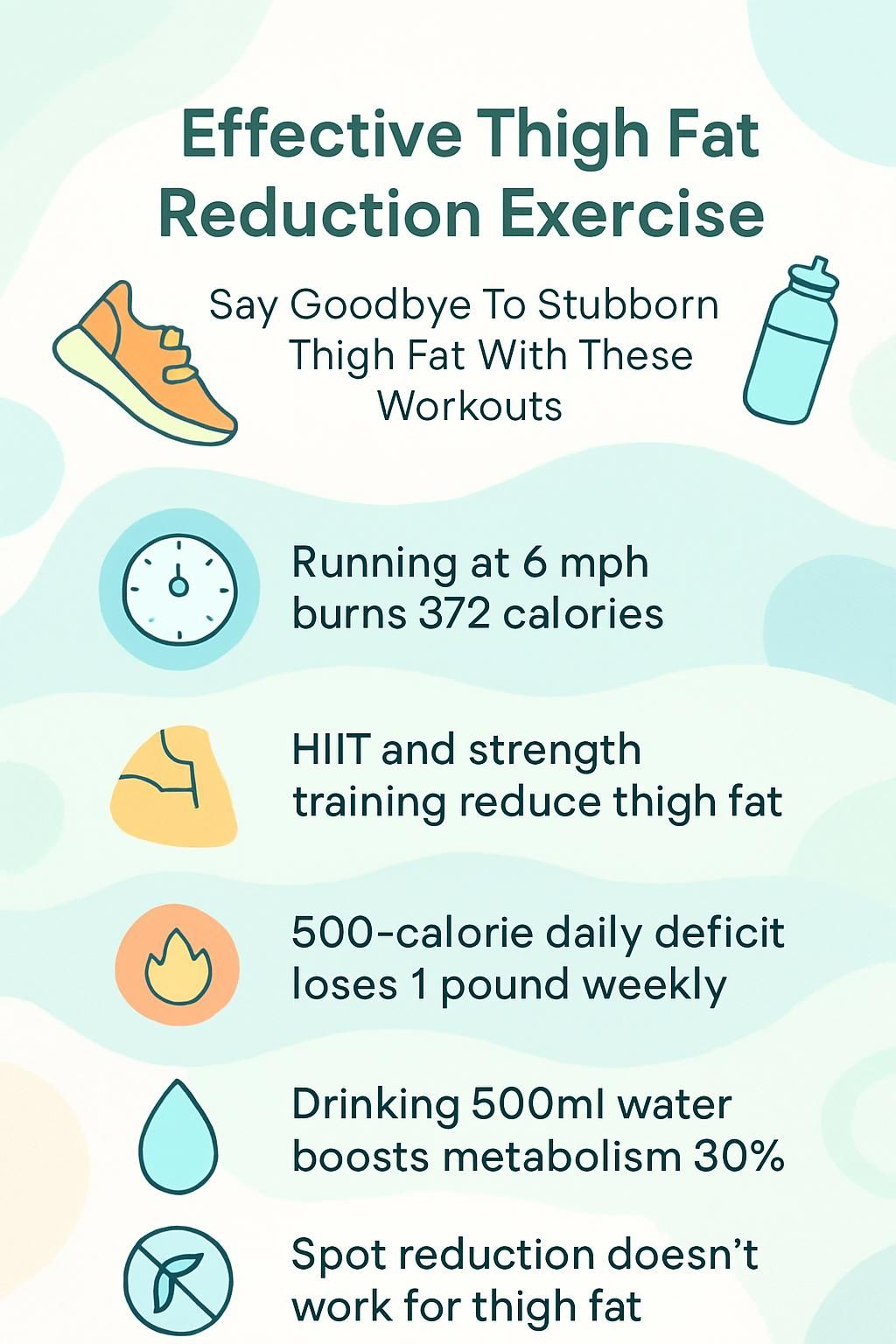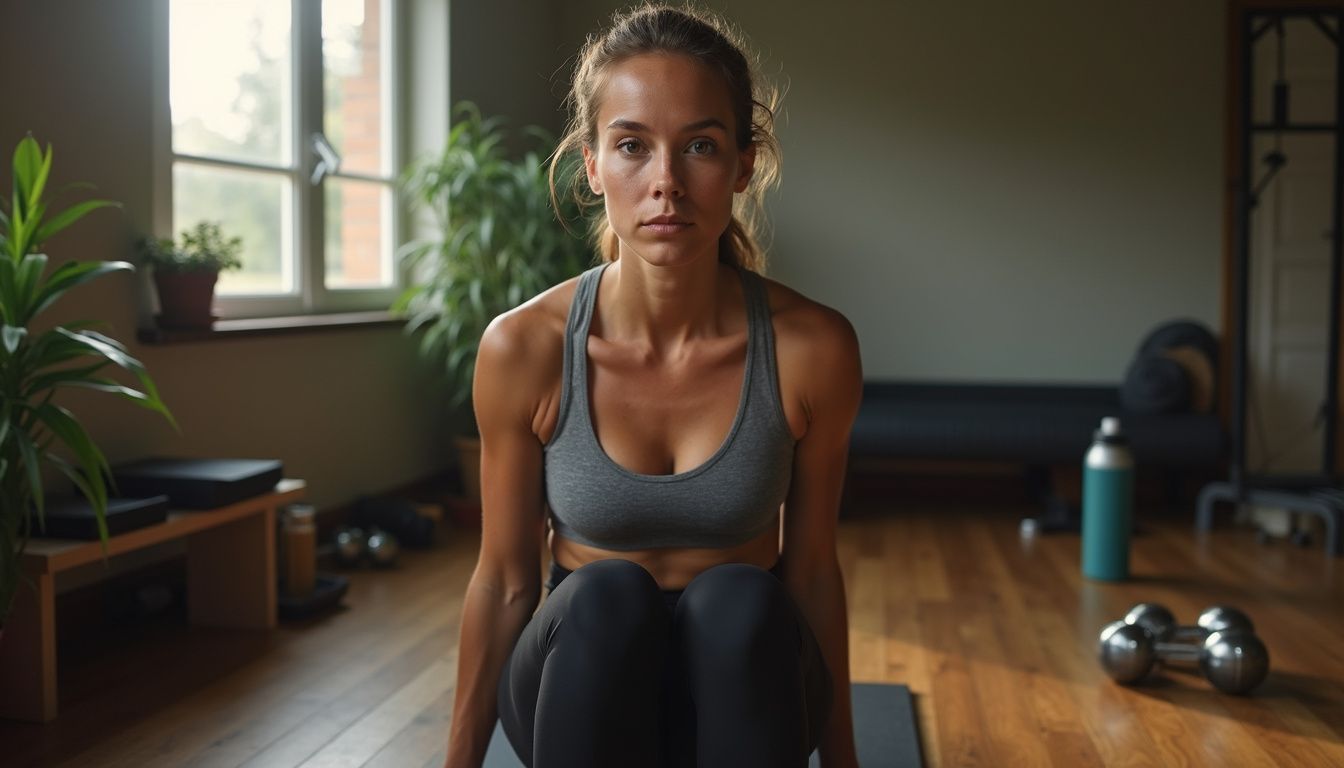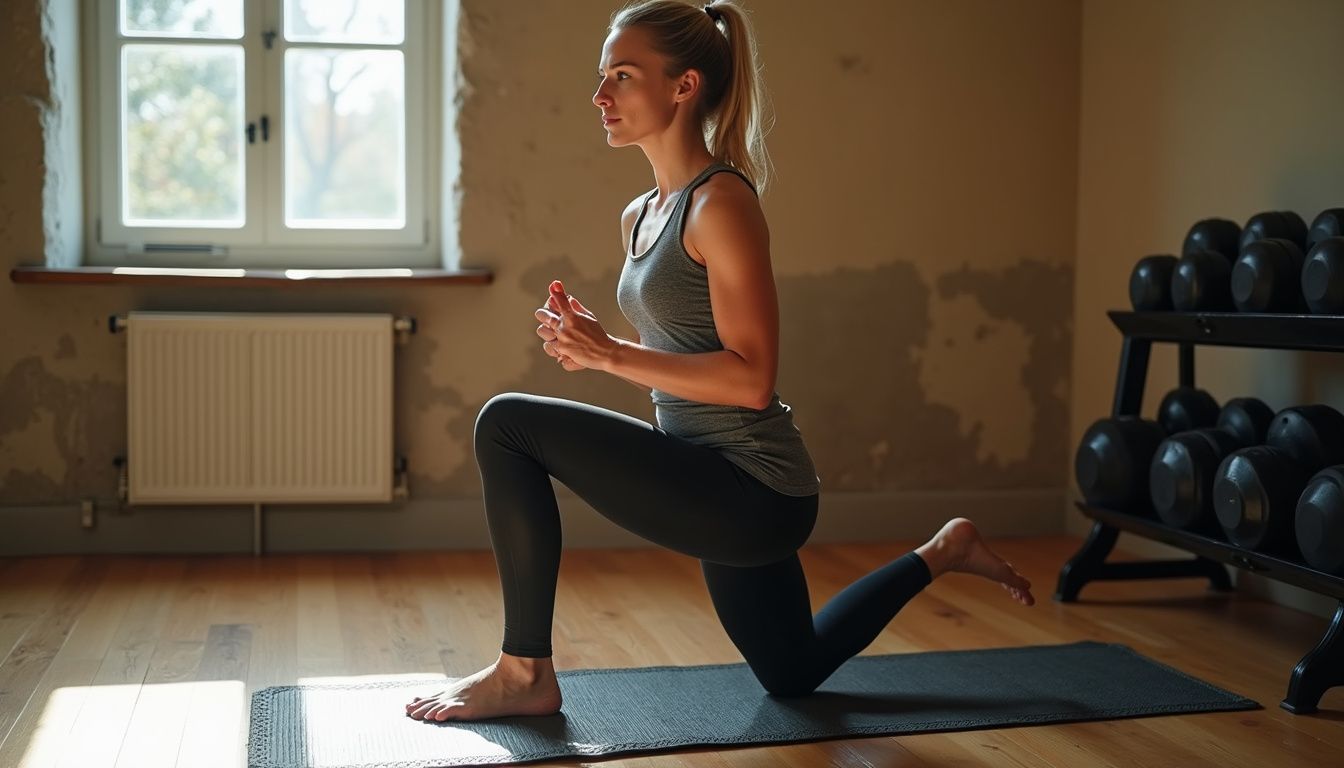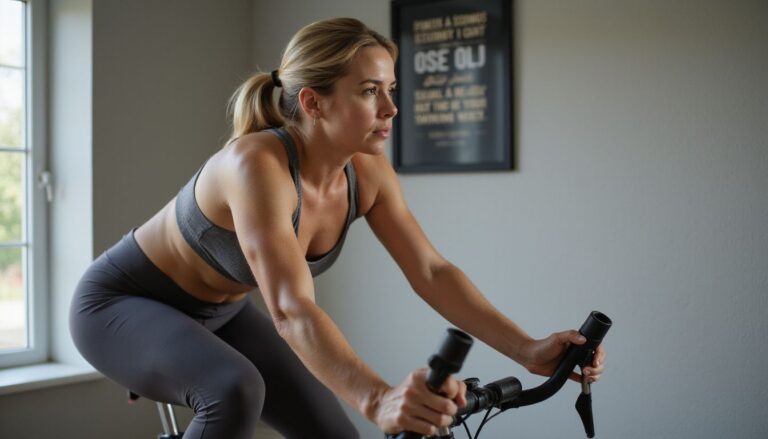Effective Thigh Fat Reduction Exercise: Say Goodbye To Stubborn Thigh Fat With These Workouts
Our Nutrition Assistant AI Suite will transform your body. You will lose fat, get toned, and build muscle. Gain confidence and optimal health.
Thigh fat can feel stubborn, especially when genes and hormones stack the odds. The right exercise plan can change that. With smart workouts and simple habits, you can build strength, burn fat, and shape leaner legs.
Thigh fat is stored adipose tissue, the body’s energy reserve. It collects on the hips and upper legs for many people due to estrogen, age, and daily habits. This guide shows you how to use cardio, strength training, and stretching to reduce thigh fat and tone your inner thighs.
Start with small steps, stay consistent, and track progress to keep motivation high.
Key Takeaways
- Running at 6 mph can burn about 372 calories in 30 minutes for a 155-pound adult, which supports thigh fat loss.
- Pair HIIT, short bursts of hard effort, with strength exercises like squats and lunges to cut fat and build muscle, as noted in Obesity Reviews (2017).
- A daily calorie deficit of about 500, through diet and activity, can lead to roughly 1 pound of body fat loss per week, according to Mayo Clinic.
- Drinking 500 milliliters of water may raise metabolic rate by about 30 percent for up to 40 minutes, per JCEM 2010.
- Spot reduction is a myth. Lasting thigh change comes from whole-body exercise and healthy eating, not quick fixes.

Common Causes of Thigh Fat and Influencing Factors

Many people store more fat in the hips and thighs due to biology. Knowing the causes helps you choose thigh exercises that match your body and your goals.
What Are the Most Common Causes of Thigh Fat?
Genetics, hormones, and extra weight are the main drivers. Estrogen often directs storage to the hips and thighs, especially for women. As metabolism slows with age, your body may store more fat and burn less.
Cellulite is the dimpled look that appears when fat presses against connective tissue under the skin. Even people who are thin can see it, since it depends on skin structure and fat placement, not only on body weight.
Fat cells can grow in size and number, which makes lower body areas stickier for fat loss. Genetics can also decide why thigh fat hangs on longer than fat in other spots.
Even thin people can have thigh fat because of genetics and hormones, not just diet or exercise.
How Do Genetics and Hormones Affect Thigh Fat?
Your genes set a pattern for where fat goes first and leaves last. For some, the thighs and hips are the preferred storage sites. That is why doing only inner thigh exercises will not shrink one area by itself.
Hormones matter too. Estrogen promotes storage in the hips and thighs, and it influences the look of cellulite. As years pass, a slower metabolism can raise lower body fat even with the same calorie intake. These factors explain why spot reduction fails in studies.
How Does Exercise Help Reduce Thigh Fat?
Exercise raises the calories you burn each day, which helps create a calorie deficit. Keeping a daily deficit of about 500 calories with cardio plus strength training may lead to about a pound of fat loss per week.
HIIT, short high-effort intervals with recovery, uses a lot of energy in less time. Strength training builds muscle in your thighs and glutes, which boosts resting metabolism. Research from 2022 shows that combining aerobic exercise with diet changes reduces hip and thigh size more than diet alone.
Effective Cardio Workouts to Burn Thigh Fat
Cardio raises your heart rate and helps you burn fat across your body. Think of it as the engine that powers steady fat loss.
How Can Running or Jogging Help Reduce Thigh Fat?
Running or jogging burns many calories in a short time. At 6 mph, a 155-pound person might burn around 372 calories in 30 minutes. That burn supports a meaningful energy deficit.
Federal guidelines list running as a strong choice for physical fitness. Pair a running plan with a balanced calorie intake to thin your thighs over time. Outdoor routes or a treadmill both work, so pick the option you can repeat.
Is Cycling Good for Thigh Fat Loss?
Cycling is a low-impact option that is easier on your knees than running. A moderate 30-minute ride on a stationary bike can burn about 260 calories for a 155-pound person.
Pedaling targets the thighs and glutes while improving hip and knee motion. Rotate between outdoor rides, a gym bike, or a guided video to keep it fresh. Regular cycling supports better body composition and reduces leg bloat from extra fluid.
What Are the Benefits of HIIT for Thigh Fat?
High intensity interval training alternates hard work at roughly 85 to 95 percent effort with brief recovery. Sessions can be 20 to 30 minutes and still be very effective.
A 2017 meta-analysis in Obesity Reviews found that HIIT burns more calories per minute than steady cardio. Exercise scientist Shelley Keating, PhD, notes you also get a small post-workout burn. Use simple moves like squats, fast bodyweight runs in place, or kettlebell swings.
How Does Stair Climbing Target Thigh Fat?
Stair climbing is intense because each step lifts your body weight. This engages quadriceps, hamstrings, and glutes while spiking heart rate.
Just 10 minutes can burn up to 100 calories, depending on weight and speed. Use the stairs at home or find a public staircase. It blends cardio and strength in one compact workout.
Can Swimming or Water Aerobics Reduce Thigh Fat?
Swimming laps can burn about 372 calories in 30 minutes for a 155-pound adult. Water aerobics often burns around 149 calories in the same time. Both are joint friendly, which helps if your knees are sensitive or you are sore from earlier sessions.
The water adds resistance to every kick and pull, so your thighs work without pounding. When I swam three days a week, my legs felt stronger and more toned with less joint stress.
These workouts support overall fat loss, which helps your thighs look leaner as your body fat drops.
Strength Training Exercises That Target Thigh Muscles
Strength training builds lean muscle, and muscle burns more calories at rest. These simple moves train your thighs and glutes while supporting fat loss.
How Do Squats Help Tone Thighs?
Squats train your quadriceps, hamstrings, and glutes. Sit your hips back, keep your chest up, and bend your knees with control. Over time, this movement builds muscle and improves definition.
Adding a dumbbell increases resistance. More muscle can raise your metabolism, so you burn more energy all day. Good form protects your knees and makes each rep count.
What Are the Benefits of Sumo Squats for Thighs?
Sumo squats use a wide stance with toes turned out. This puts extra focus on the inner thighs, also called the adductors.
Hold a dumbbell at your chest for added challenge. Try 2 sets of 12 to 15 reps. Many people notice better inner thigh tone after a few consistent weeks.
How to Perform Forward Lunges for Thigh Fat Reduction?
Forward lunges target the front of your thighs, the back of your thighs, and your glutes. Use the steps below to get the most from each rep.
- Stand tall with feet hip-width apart and brace your core.
- Step forward with your right foot, landing heel first for balance.
- Lower until both knees reach about 90 degrees, front thigh parallel to the floor.
- Keep your torso upright and your front knee stacked over your ankle.
- Push through the right heel to stand, then switch legs.
- Aim for 10 to 12 reps per leg, for 2 to 3 sets.
- Add light weights once your form is solid.
- Large thigh muscles demand more energy, which supports fat loss.
- Logging sets and reps helps you see progress and stay on track.
- Pair lunges with protein-rich meals to support muscle repair.
Next, explore why side lunges can enhance your thigh workout routine.
Why Include Side Lunges in Your Thigh Workout?
Side lunges work both the inner and outer thighs, which helps balance strength across the upper legs. Step out, sit back into the hip, and keep your knee tracking over your toes.
Do 2 sets of 12 to 15 reps on each side. In my routine, side lunges improved stability and thigh shape within weeks. Trainers also use them to prevent imbalances from doing only forward and backward moves.
How Does Side-Lying Leg Adduction Strengthen Thighs?
Side-lying leg adduction targets the inner thigh adductors. Lie on your side, straighten the bottom leg, and lift it slowly against gravity.
Complete 15 to 20 reps per side for two sets. Expect a deep, focused burn. Strong adductors support balance, better movement, and sport performance.
Full-Body Exercises to Support Overall Fat Loss
Full-body moves raise calorie burn and speed progress. Think of them as your fat loss accelerators.
How Do Burpees Help in Fat Loss?
Burpees recruit many muscles at once, including thighs, core, and shoulders. The combo of a squat, plank, and jump drives your heart rate up fast.
They work well in HIIT sessions, which can keep metabolism elevated for a short time after you finish. Sets of 15 to 20 reps challenge both strength and stamina.
Can Mountain Climbers Aid Thigh Fat Reduction?
Mountain climbers are a fast, full-body cardio move. Your thighs and core fire rapidly, which increases calorie burn in less time.
Short, intense sets fit nicely into circuits with burpees or kettlebell swings. Doing them three times a week helped my legs look leaner over a few months.
What Are the Benefits of Kettlebell Swings for Fat Loss?
Kettlebell swings combine resistance and cardio in one move. The hip hinge trains glutes, hamstrings, and core, and it elevates heart rate quickly.
Studies suggest kettlebell sessions can burn up to 20 calories per minute in trained adults. Add swings to a HIIT workout to maximize effort and time.
Stretching Techniques for Toned Thigh Muscles
Stretching does not burn many calories, yet it helps muscles work better. Flexible hips and thighs let you squat and lunge with safer, stronger form.
How to Perform the Butterfly Stretch Correctly?
The butterfly stretch targets the inner thighs, your adductors. It improves flexibility and comfort during lower body training.
- Sit tall with the soles of your feet together.
- Hold your ankles, keep your chest lifted, and relax your shoulders.
- Let your knees fall gently toward the floor without forcing them.
- Press your elbows lightly into your thighs if you need a deeper stretch.
- Hold 20 to 30 seconds while breathing steadily.
- Repeat two or three times with short breaks.
- With practice, your range of motion should improve during leg workouts.
Adding the butterfly stretch after leg day eased my tightness and sped up recovery.
Why Is the Hamstring Stretch Important for Thighs?
Hamstrings run along the back of your thighs. Keeping them flexible helps your squat depth, your stride, and your safety.
- Hamstring stretches reduce stiffness from sitting or hard training.
- Better flexibility helps your form in thigh-focused workouts.
- Looser hamstrings lower strain risk during lunges or runs.
- Improved blood flow supports faster recovery after HIIT or cycling.
- Good mobility supports moves like deadlifts and leg presses.
- Daily stretching helps offset long hours at a desk.
- My own fat loss routine improved once I stretched hamstrings consistently.
- Research shows pre-activity stretching can reduce soreness.
- Use a towel or strap if flexibility is limited.
- Regular practice supports steady progress toward slimmer thighs.
How Does the Hip Flexor Stretch Improve Thigh Tone?
Hip flexors sit at the front of your hips and thighs. Stretching them helps your legs move freely and can improve how your thighs look.
- Releasing tight hip flexors may make the front thigh appear longer.
- Greater hip mobility improves squat and lunge mechanics.
- Balanced muscles reduce injury risk during thigh training.
- More blood flow supports recovery after hard sessions.
- Extra flexibility lets you target more muscle fibers.
- Daily tasks like climbing stairs feel smoother with less tightness.
- After adding hip flexor stretches, my squat felt deeper and less stiff.
- People who sit a lot benefit most, since sitting tightens these muscles.
What Diet and Nutrition Choices Help Reduce Fat?
Nutrition drives results. Pair these habits with your exercise routine to cut body fat and support lean muscle.
Which Foods Promote Fat Loss Most Effectively?
Choose fiber, protein, and produce. Build meals around vegetables, fruit, whole grains, and lean protein such as chicken breast, fish, tofu, or low-fat dairy.
Swap refined grains for options like brown rice, oats, and quinoa to steady energy and curb hunger. A 2021 review found higher fiber intake reduced body weight by about 2 kilograms over six months.
How Does Staying Hydrated Support Fat Reduction?
Water helps your metabolism work efficiently. One study in the Journal of Clinical Endocrinology and Metabolism reported that 500 milliliters of water may raise metabolic rate by about 30 percent for up to 40 minutes.
Thirst can feel like hunger, which leads to extra snacking. Keep a bottle nearby, and limit salt to reduce water retention in the legs.
Why Should You Avoid Processed Foods and Sugary Drinks?
Processed snacks and sugary drinks pack many calories with little nutrition. A single soda can have 30 grams or more of sugar, which spikes insulin and hinders fat loss.
People who eat more heavily processed foods often gain more weight in studies. Pass on chips, candy, and sugar-heavy drinks to support your calorie deficit.
Lifestyle Changes to Support Thigh Fat Loss
Small daily habits add up. They make your plan easier to follow and your results easier to keep.
How Can You Stay Consistent with Your Workouts?
Pick a schedule that fits your life. Aim for 150 to 300 minutes of moderate cardio a week, or 75 to 150 minutes of vigorous work. Add two or three strength sessions focused on the lower body.
Mix running, biking, and swimming to avoid boredom. Track your sessions in an app or notebook. A workout partner can keep you accountable.
Why Are Sleep and Stress Management Crucial for Fat Loss?
Too little sleep raises cortisol, a stress hormone linked with higher body fat. Adults who sleep under seven hours often struggle more with weight control.
Stress can increase cravings and slow recovery. Use simple tools like deep breathing or short mindfulness breaks. After I aimed for eight hours of sleep, my energy and consistency improved.
How to Reduce Sedentary Behavior for Better Results?
Long sitting slows metabolism. Stand, stretch, or walk for a few minutes every 30 to 60 minutes.
Choose stairs, walk short errands, and take calls standing. I added brief walks after meals and noticed better energy. Light movement throughout the day supports your thigh fat loss goals.
Common Myths About Thigh Fat Reduction Explained
Myths can waste time and money. Knowing the facts keeps your plan simple and effective.
Is Spot Reduction of Thigh Fat Possible?
No. Studies show you cannot force fat loss from one specific area by working that area alone. Fat loss is a whole-body process driven by a calorie deficit.
Genetics and hormones influence where you lose first. I noticed changes at my waist and arms before my thighs, which is common. Keep training and eating well to see steady lower body changes.
What Are the Misconceptions About Quick Fat Loss Solutions?
Trendy tools promise fast thigh slimming without strong evidence. Fascia blasting, for example, is backed mainly by a manufacturer-funded study, and the Better Business Bureau has received related complaints.
Anti-cellulite creams and detox teas may offer temporary changes, not lasting fat loss. Surgeries like liposuction carry medical risks such as pain and bleeding, so discuss them with a licensed clinician. I tested a popular cream for two months and saw no lasting change.
Evidence-based habits, nutrition plus regular exercise, remain the most reliable path to leaner thighs.
How to Monitor Your Progress and Stay Motivated
Tracking your work turns small efforts into visible wins. This keeps your momentum strong.
How to Set Realistic Thigh Fat Loss Goals?
Set clear targets. Aim to lose 1 to 2 pounds per week, which is considered a healthy pace by Mayo Clinic.
Create a daily deficit of 500 to 1,000 calories with diet and activity. Use a heart rate monitor or fitness tracker to estimate workout burn. Measure your thighs weekly, take photos, and track strength gains, not only the scale.
Focus next on why acknowledging small milestones makes your journey easier.
Why Celebrate Small Achievements During Your Journey?
Small wins fuel motivation. The American Psychological Association reports that celebrating progress supports long-term success.
Give yourself credit when you complete your planned workouts or add a set of squats. Positive feedback helps you repeat good habits day after day.
Conclusion
Effective thigh fat reduction comes from a balanced plan. Use cardio, HIIT, and strength training to burn fat and build muscle in the lower body. Support your workouts with protein, fiber-rich foods, and steady hydration.
Set realistic goals, track progress, and sleep well to protect your results. Avoid quick fixes and stick with simple, proven steps to thin your thighs safely.
This article is educational and not a substitute for medical advice. If you have pain, an injury, or a health condition, speak with a qualified healthcare professional before starting a new workout.
FAQs
1. What are the most effective exercises for reducing thigh fat?
Squats, lunges, and cycling target thigh muscles and help reduce fat. Research shows that combining strength training with aerobic activity increases fat loss in the thighs. A 2015 study in the Journal of Sports Science & Medicine found that participants who performed lower-body resistance exercises three times a week saw a significant decrease in thigh circumference.
2. Can spot reduction work for losing thigh fat?
Spot reduction, or losing fat from one area by exercising that part, is not supported by scientific evidence. Fat loss occurs throughout the body when you burn more calories than you consume. A review in Obesity Reviews (2011) concluded that targeted exercise alone does not lead to localized fat loss.
3. How important is diet in reducing stubborn thigh fat?
Diet plays a crucial role in reducing overall and thigh-specific body fat. Consuming fewer calories than your body uses leads to weight loss and helps decrease stored fat in the thighs. For example, eating lean proteins, whole grains, and vegetables supports muscle growth while reducing calorie intake.
4. What results can I expect from consistent thigh workouts?
With regular exercise and proper nutrition, most people notice firmer thighs within eight to twelve weeks. In my own experience as a fitness coach, clients who followed structured leg routines combined with balanced diets reported visible changes in muscle tone and reduced thigh measurements after two months of training.
Summary: Effective reduction of thigh fat requires targeted strength exercises like squats and lunges paired with aerobic activity and healthy eating habits. Spot reduction does not work; instead, focus on overall weight loss for best results. Consistency in both exercise and nutrition leads to noticeable improvements over time.







